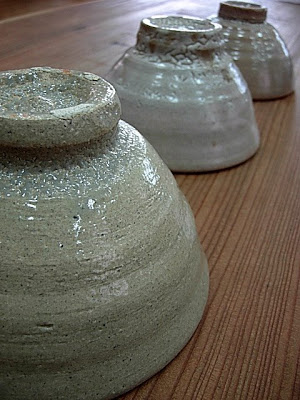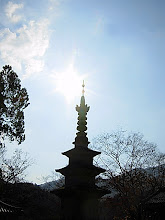
Please read the post A Test In the Art of Edo Style to understand the following...
You readers are a smart bunch! Tea Bowl #1 is of lesser monetary value made buy a much younger and inexperienced, all though extremely popular, artist. Bowl #1 was made by the hands and kiln of Kim Kyoung Soo. So lets look at this Edo Tea Bowl...
The shape of this bowl is a little on the hardy side. It looks a little too bulky for a graceful, soft, and gentle Edo bowl. The main body of the bowl is also quite thick. The high firing of thin ceramics is difficult to do without overheating and cracking the bowl in the kiln. So buncheong style bowls that have thin walls are generally valued higher then those with thin walls. Although these shape characteristics detract from the Edo style, they are also what make this bowl alluring. Edo style aside, this bowl feels sturdy and grounding. One can see how it could be treasured and used under certain circumstances to evoke this feeling.
The clay of this bowl is of lesser quality. For some reason beyond my knowledge the clay used for this tea bowl doesn't share the clay of a quality Edo bowl. Perhaps the clay is expensive, or is difficult to find or obtain, or maybe it was just a creative decision by Kim Kyoung Soo to use a different clay. Either way the clay used is on the duller side where as the muted pinkish-orange is the most sought after. The best place to view the clay of a tea bowl is on the unglazed foot. Here a greyish hue can be seen from this bowl.
The glaze of this bowl is thick and glossy not quite ideal for the muted calm of an Edo bowl. This thick style of applying the glaze is somewhat of a characteristic of Kim Kyoung Soo and can be seen on his other bowls pictured here, and here. So again, one wonders if it was done deliberately.
The foot of this bowl doesn't resonate the look or feel of the blooming Mae Hwa. Firstly, the globing technique doesn't engulf the exposed clay and make it come alive. Secondly, there is something about the shape of the collared-like foot that, once again, exudes a certain huskiness to it.
Either way, given a certain mood, this bowl could really enhance your experience with tea and even be chosen over the other two.
Tea Bowl #2 was made by the hands of artist Chan Han Bong, a ceramic master and mentor of Kim Jeong Pill. This bowl is beautiful in its shape, colour, and glaze. The shape seems in proportion, and conveys a sense of grace and balance. This bowl feels quite right in one's hands. More than any of the three, this bowl conveys a sense of safety and security. The colour of this bowl is soft, muted, and at peace with the rest of the bowl. The glazing is of excellent quality on this bowl. The glaze lightly coats this piece allowing cracks to share its air with the tea. The soft white glaze looks like the soft clouds of early morning, that pulls and bases the colour of the clay, the colour of a soft sun rise. As one peers inside the tea bowl one can see soft white slowly converging upon the shallow of this bowl. What a wonderful effect. The foot of this bowl is also quite beautiful as air holes creep their way down toward the foot. The unglazed clay beneath the glaze resembles the branches of the Mae Hwa and the white blobs the full white blossoms. What a wonderful tea bowl.
Tea Bowl #3 by Jung Jum Gyo was chosen as the favorite of the three by all those who left a comment on the blog. Consequently, it is also one's favorite and also the most expensive of the three, more than doubling Chan Han Bong's Tea Bowl in price. So, what makes this tea bowl so special?
The shape of this bowl is wonderful, it exudes a feeling a grace, maybe even shyness. Its shape looks and feels elegant, but not showy. The walls of this bowl are also thinner than the other two, validating the feeling of gracefulness. The outside body of this tea bowl displays three rings that jut out slightly from the bowl. These three rings are quite valued on tea bowls and give the hand that cradles the bowl maximum contact with the bowl and a sense of unimposing security. Creating a bowl that contain these three rings while still conveying a sense of subtly and naturalness in form is no easy task. Jung Jum Gyo did a great job pleasuring the hands on this bowl.
This bowl's colour seems to radiate such natural pinky-orange softness, the most beautiful of the three. It's thin glaze can barely contain the peaceful glow of this bowl. The small cracks in this bowl supply the bowl with ample air as well as beauty. On the foot of this bowl, the glazing seems to portray 'the skin of the Mae Hwa'. The size of the foot seems a bit smaller than it should, but it makes up for it in its form. The shape of this foot is an excellent example of what a good Edo foot should look like. Unlike the foot of Chan Han Bong's bowl, the outside collar of this foot first juts in before jutting out. The collar is small and retains a sense of grace without looking clumsy and jolting like the foot of Kim Kyoung Soo's Edo bowl. This bowl simply has too many beautiful features to not be chosen as the most beautiful of the three!
Thanks again for your comments. You guys passed the test with flying (but subtle pinkish-orange) colours!
Peace

4 comments:
Wow! I can't believe we were all right! Thanks for sharing the details of these bowls, they are all lovely and it is nice to know more about the craftsmen who make them. It was a fun game, too. :)
Brent
Nice to have your comment about these pieces !
Brent and Ginkgo,
Your comments really add to the posts. One always enjoys reading what you have to say whether it be about tea, ceramics, or life.
Peace
This is wonderful! Matt, thanks again for such a interesting details. I did a search on Jung Jum Gyo and "HE" is in his early 60s. Very interesting history of him.... Do you have more of his examples? Perhaps that will be your 3rd test : ) Can't wait.... Toki
Post a Comment